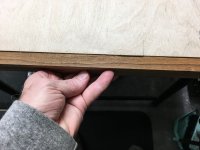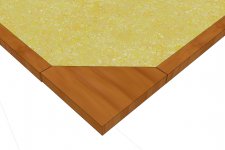Hi. I'm building two adjustable height computer workstations and need some advice about the desktop edging.
The workstation is being build using these legs: VIVO Electric Stand Up Desk Frame and building the desktops. Building the legs has been easy so far. However, the desktops need to fit into a certain space and be comfortable to use while spending long hours typing. So buying standard desktops won't work well.
Given that they are computer workstations, the top will be a nice WilsonArt laminate sheet on two 1/2" Baltic Birch sheets glued together to make a 1" substrate. I've glued up a trial BB desktop to test the process. Using contact cement glue the BB sheets together worked fine. It's the edging that bothers me.
I want to put a 45 degree bevel on edge where my arms will be hit the desktops. And two corners on one desk should be rounded (2" and 3" radius). I see two possibilities for the edging:
Teak edge banding - I tried pre-glued teak edge banding. Having never worked with edge banding before, my first try wasn't too bad except for some cracking in the round corners. (See first two pics.) BUT, I can't figure out how apply a decent 45 degree bevel without showing the underlying Baltic Birch.
Solid teak edge - The second option is to add a solid teak edge to the BB. It would be something like 3/4"-1" wide and about 1" thick (same thickness as the BB substrate). See third pic. I think Dominos may work for strength and alignment. This appeals to me and solid wood would be easy to rout a 45 degree bevel, but I can't figure out how to create the 2-3" rounded corners.
Here is a YouTube video of what a laminate desktop with solid wood edges might look like: Laminate Desktop
I would very much appreciate any feedback on this project. Any other edging options? Any better ways to install the edging?
Thanks and regards,
Dan.
P.s. Since that I have a knee operation scheduled for November, 28th, these desks need to be done by the end of October. (Since the desks will not have modesty panels, this would allow my leg to sit out straight on a stool or something.)
P.p.s. The subject was edited to make clear that the topic was about the desktop edging.
The workstation is being build using these legs: VIVO Electric Stand Up Desk Frame and building the desktops. Building the legs has been easy so far. However, the desktops need to fit into a certain space and be comfortable to use while spending long hours typing. So buying standard desktops won't work well.
Given that they are computer workstations, the top will be a nice WilsonArt laminate sheet on two 1/2" Baltic Birch sheets glued together to make a 1" substrate. I've glued up a trial BB desktop to test the process. Using contact cement glue the BB sheets together worked fine. It's the edging that bothers me.
I want to put a 45 degree bevel on edge where my arms will be hit the desktops. And two corners on one desk should be rounded (2" and 3" radius). I see two possibilities for the edging:
Teak edge banding - I tried pre-glued teak edge banding. Having never worked with edge banding before, my first try wasn't too bad except for some cracking in the round corners. (See first two pics.) BUT, I can't figure out how apply a decent 45 degree bevel without showing the underlying Baltic Birch.
Solid teak edge - The second option is to add a solid teak edge to the BB. It would be something like 3/4"-1" wide and about 1" thick (same thickness as the BB substrate). See third pic. I think Dominos may work for strength and alignment. This appeals to me and solid wood would be easy to rout a 45 degree bevel, but I can't figure out how to create the 2-3" rounded corners.
Here is a YouTube video of what a laminate desktop with solid wood edges might look like: Laminate Desktop
I would very much appreciate any feedback on this project. Any other edging options? Any better ways to install the edging?
Thanks and regards,
Dan.
P.s. Since that I have a knee operation scheduled for November, 28th, these desks need to be done by the end of October. (Since the desks will not have modesty panels, this would allow my leg to sit out straight on a stool or something.)
P.p.s. The subject was edited to make clear that the topic was about the desktop edging.





